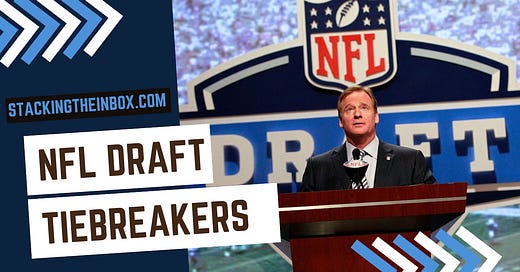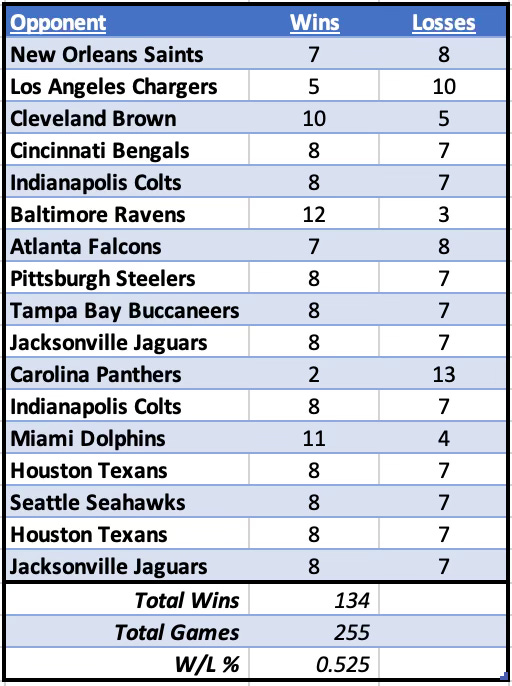[FREE] The Tennessee Titans and NFL Draft Tiebreakers
A Holiday Guide to how Tiebreakers work for the NFL Draft in relation to the Tennessee Titans.
Get 20% off forever by clicking the button below.
Hope everyone had a happy holiday, and while this won’t be an in-depth article or anything, I did want to give a free treat to everyone.
If you’re not a paid subscriber yet, this gives you just a glimpse of the work I do for paid subscribers. I do all the math-ing, researching, etc. That other sites may not care to do or have the time to do. So, I like to break down certain aspects of this game we all love to make it more digestible while also trying to help make you smarter.
Today’s topic is all about the tiebreaking procedures employed by the NFL when it comes to draft positioning. The Titans are in the midst of the Kentucky Derby for loser teams when it comes to draft positioning. They’re constantly in-flux week-to-week. So, with the emergence of sites like Tankathon.com it can be quite confusing as to how or why the Titans shift up and down as they do. So, let’s break it down.
What’s the Tiebreaking Method
We all know that draft order is mainly decided for non-playoff teams based on record. The worse your record the higher you pick in the first 18 picks. But what happens if a lot of teams are tied? Well, that is where things get tricky.
The first thing the NFL looks at who you’re tied with and puts them in one of three categories based on who that team is:
In-Division Team
In-Conference Team
Out-of-Conference Team (is this hyphenated? Who knows.)
From there, the NFL employs minorly different tie-breaking procedures if your win-loss records are the same. However, they do all share the next step in the order of tiebreaking procedures: strength of schedule. (SOS)
Just in case you’re not familiar with how strength of schedule is calculated here’s how it works:
Take all 17 opponents on a team’s schedule.
Plug in their win-loss records.
Add up the wins.
Divide the Win total by the total number of games played.
Whoever has the worst SOS (the lower number) wins the tiebreaker.
The biggest thing to note, in my opinion, is that it goes ahead and takes all 17 opponents. So, it looks something like this:
So, what if you have the exact same strength of schedule? This is where a site like Tankathon can kind of screw with your head. They’re not a predictive web site when it comes to SOS. They take what they currently have as win/loss records and calculate strength of schedule like that. The NFL and sites with a mock draft machine look at it predictively if both teams have played a game that week but share common opponents or have opponents left on their schedule have yet to play.
Ok, that is a little confusing, I am sure. However, a few weeks ago I noticed a discrepancy in what Tankathon had and what either Field Yates or Tom Pelissero posted. It was a one spot difference, if I recall correctly, but I wondered why they had given the tiebreaker to the other team. Games were played and then Tankathon updated. So’ they’re reactive not proactive.
Still not clear? That’s okay, we can use the recent swing in the Chargers and Titans placement. Before the Christmas Day game, the Titans were at pick five and the Chargers at six according to Tankathon.com. I noticed, however, that PFF’s Mock Draft Machine had it reversed. So, this caused me to do some diving about who was right and why.
Before the Christmas Games
Chargers SOS: 0.524
Titans SOS: 0.5236
So, Tankathon used that slight decimal difference to put Titans ahead of Chargers. I do not know how far the NFL goes with its decimal system but do know that right now it didn’t matter for the Chargers/Titans. The reason being is because the Titans still shared a mutual opponent of the Ravens with the Chargers, and also, the Chargers have opponents in the Chiefs and Raiders playing each other. PFF (and likely NFL) knew something no one else knew unless they took the time to calculate it:
Because they shared an opponent with the Ravens, and the Raiders/Chiefs are an in-division rivals, that no matter the outcome of those games, the Titans would have the exact same SOS as the Chargers.
Current Outcomes
Chargers SOS: 0.5254902 (0.525)
Titans SOS: 0.5254902 (0.525)
Both Games Reversed Outcomes
Chargers SOS: 0.52156863 (0.522)
Titans SOS: 0.52156863 (0.522)
Ravens Win, Chiefs Win
Chargers SOS: 0.5254902 (0.525)
Titans SOS: 0.5254902 (0.525)
Ravens Lose, Raiders Win
Chargers SOS: 0.52156863 (0.522)
Titans SOS: 0.52156863 (0.522)
So, no matter what happened yesterday, the Titans were ending up with the exact same SOS as the Chargers. Tankathon (reactive) did not know that PFF/NFL (proactive) did. Thus, invoking the next step in the NFL tiebreaker, Head-to-Head matchup. (Titans beat Chargers, so Chargers get the better draft pick). However, if they don’t play each other, they move on to the aforementioned categories they put the teams in.
If they’re in-division, they would go to their records against divisional opponents as tiebreakers. If they’re not in the same division, but in the same conference, they would go to overall conference record. If they’re not in the same division and not in the same conference, they goto winning percentage in common games. They have to have at least four opponents in common.
After that it all gets a little more complicated. In the end, if teams are still tied after every tiebreaker, they flip a coin to decide who wins the tiebreaker. If you want a full look into the tiebreaking procedures and how everything is calculated, go to this article by ProFootballNetwork.com.
This should clear up the confusion caused by Tankathon’s method of being reactive and the sudden drop from five to seven, when really it was always going to be from six to seven.
You can also share Stacking The Inbox to anyone you may think will enjoy this comment! sharing is caring!






